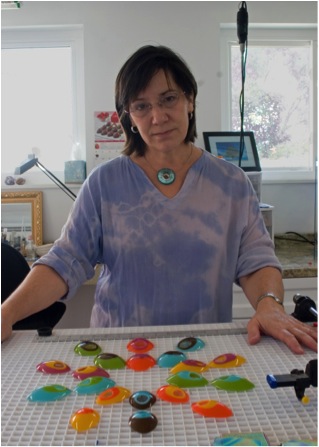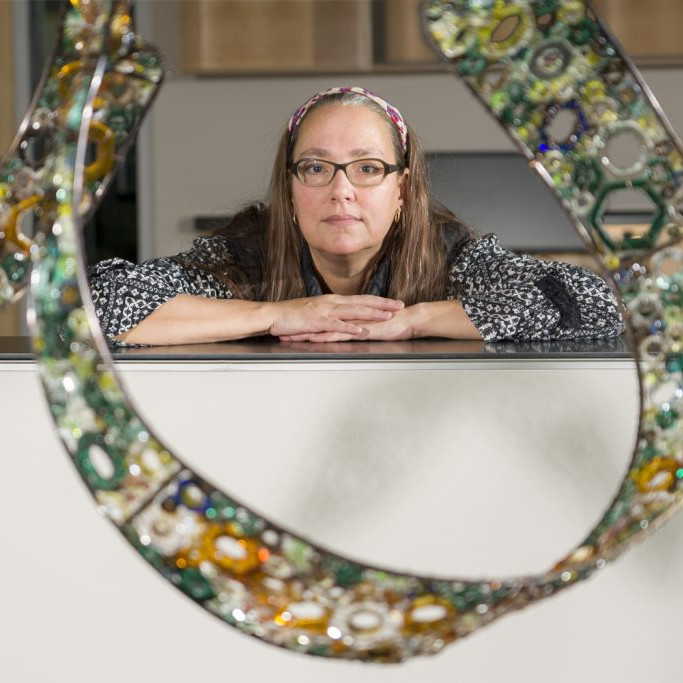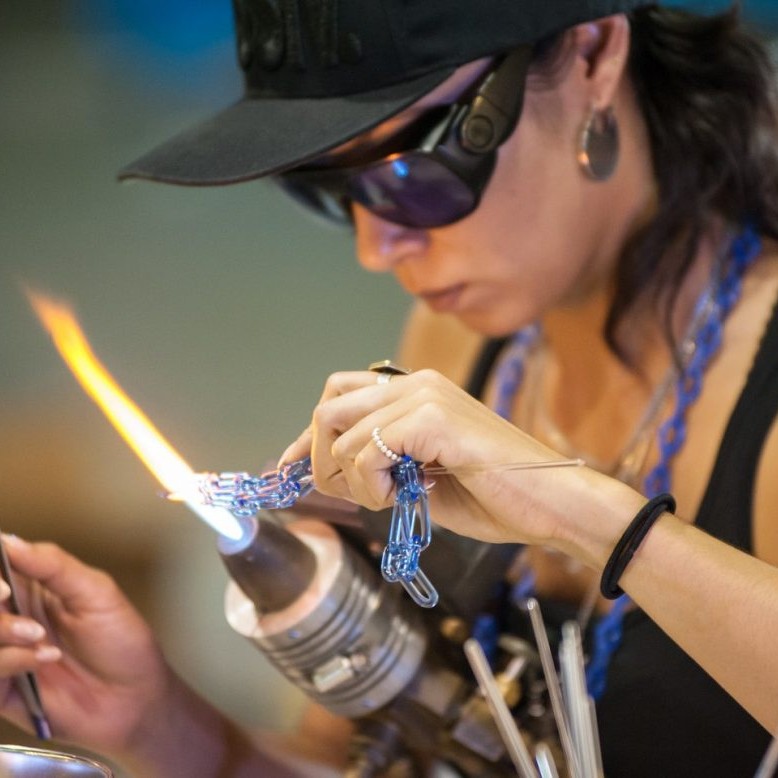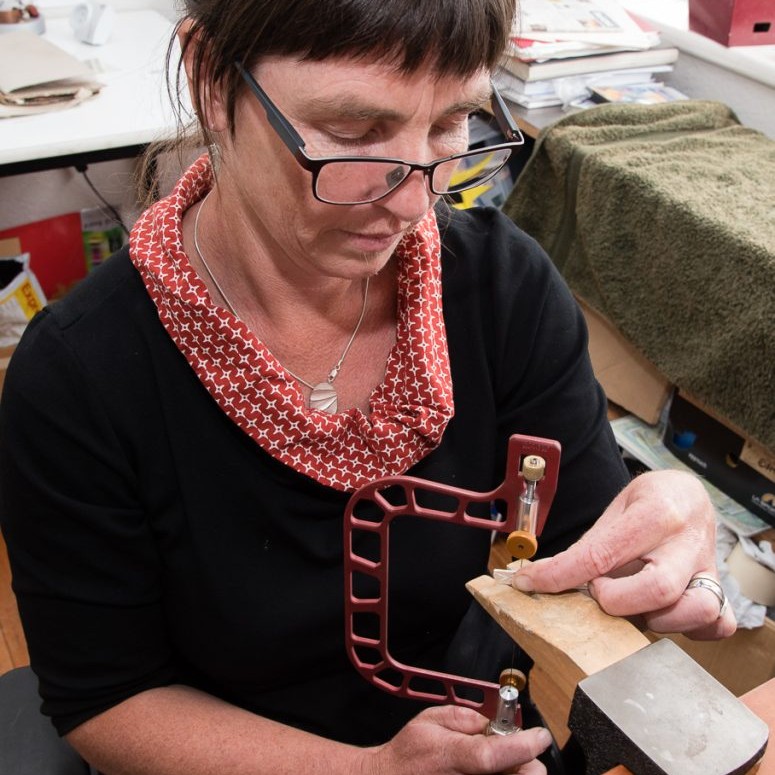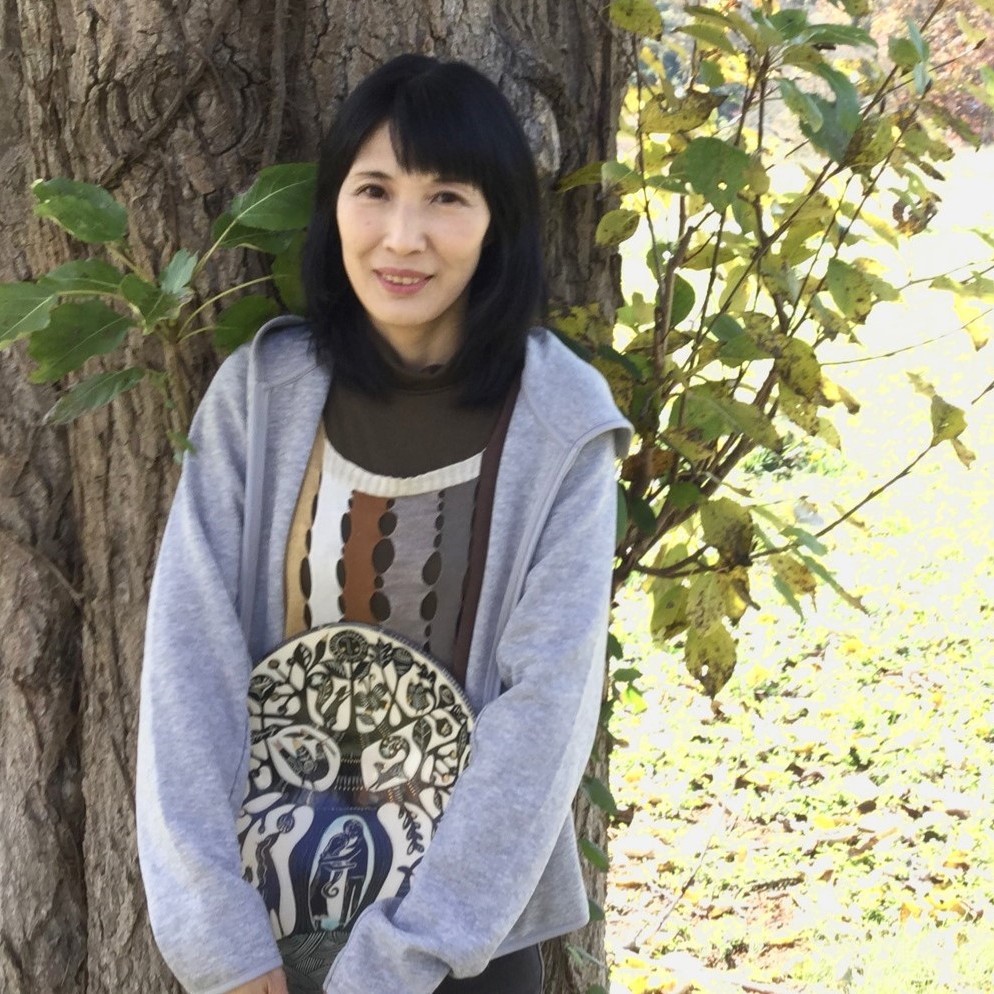Dolores Barrett Glass Jewellery Artist - California, USA
You were introduced to glass art and its beauty in 2002. Can you explain how this changed your artistic life?
It really was quite literally a life change. I was a choir director at my local church as well as a piano teacher for 20 years. My interest began to sway to the arts in 1999 when I started porcelain portraiture. I had no previous training in art. I followed some online instructions, purchased some supplies off the internet, and dove right into what I was told was the hardest discipline to master; that being a miniature portrait. The results were encouraging enough that I wanted to delve deeper. I segued into glass after experimenting with ways to use it with my porcelain work. The seductive qualities of the material very quickly took over thereafter.
That was my first major success (and nothing succeeds better than success or at least the taste of it). I became aware of the possibilities this medium had to offer. I enjoyed being a part of such a prestigious community of artists. It made me want to push all the more to stretch the medium to its limits and beyond. I wanted to go wild with the ideas churning in my imagination.
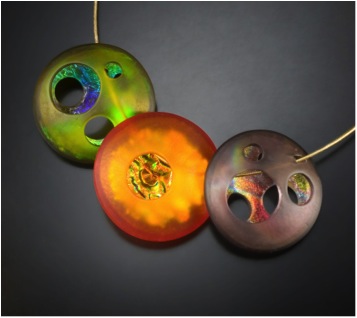
‘Atomic Orbs’
How did your residency at Pilchuck Glass School during the summer of 2008 work?
I had been part of an online glass forum for several years, and had heard many stories and experiences in regards to Pilchuck. It was generally acknowledged as the go to place for any serious glass artist. I applied for, and received a scholarship for a session under the tutelage of David Chatt. Once I abandoned the idea of trying to “produce” something, I was truly able to enjoy and grow from the experience of networking, discussion, and absorption. A lot of the little things I learned there still work for me in my studio today. I continue to enjoy designing a special piece each year for their annual auction. I get to meet up with many wonderful artists at the event, as well as support future artists who wish to attend these enriching summer sessions
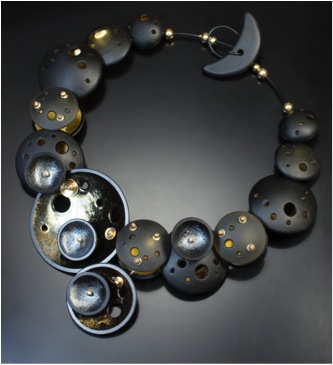
Can you expand on your ‘Gallery Showpieces’ and one-of-a-kind work?
My artistic showpieces are where I pour the heart and soul of my imagination. These are generally made specifically for exhibitions, commissions, and/or special events (like the “Fly Me To The Moon” neckpiece). This is also where I am able to experiment with a variety of alternate materials and fabrication methods. It’s a “no holds barred” situation and my creativity can truly go wild. I am able to tap into all the inspirations and design ideas that have accumulated in my head over many years from childhood onward.
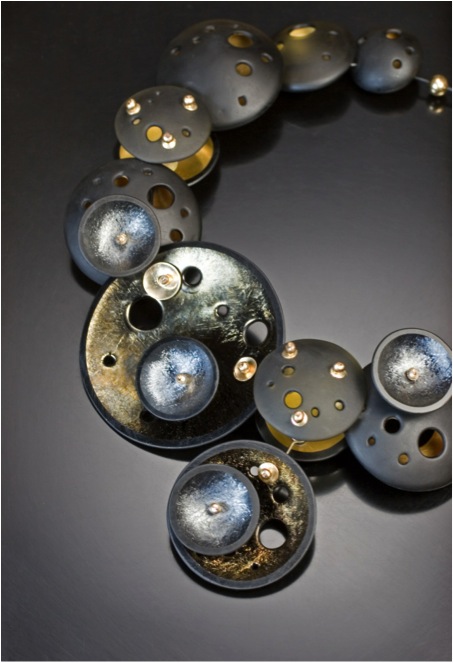
‘Fly Me To The Moon’
The process
It’s a process of internal reverse engineering really; I am introduced to the parameters required and instantaneously envision the finished product, then I must break it down to figure out how to make it a reality. I sketch the concept and proceed to a full scale paper model before beginning the work on moulds for the glass. Many times I find myself moving into completely uncharted territory where I must fabricate all the metal connectors, hanging mechanisms, and findings, as the glass pieces are very specialized and none exist in those configurations.
The design aspects
Of course, being functioning art wear, one must always consider wearability. This is precisely why I always make a model first. Not only is general appearance important, I must also consider the symmetry, potential weight, stability, and comfort of the design. I check for potential rough edges and or intrusive features. I also need to consider whether the work in its physical form conveys the intent I had in mind.
Your Precious Bead series is a combination of materials, discuss the combinations?
I really love working with gold and gold loves fusing with glass. They are quite a happy couple. With my Precious beads, I was seeking a way to “preserve” the gold for perpetuity. I cut layers of heavy gold foil and fuse them between the sheets of clear and coloured glass, then slump them into hand-carved moulds. I sandblast the exterior for a satin smooth finish, but choose to leave the coloured interiors in their luscious liquid-looking state. The dichotomy is enticing.
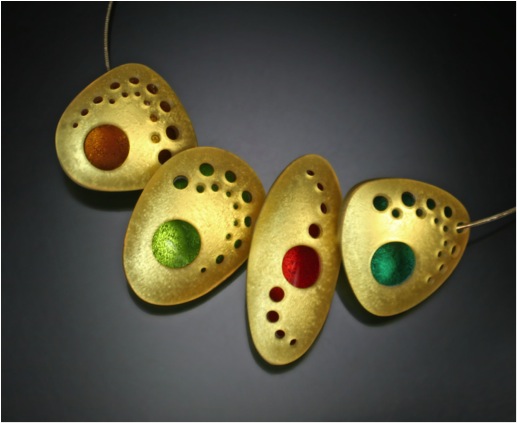
‘Precious Beads’
Your Orbit work is very 3D, can you discuss this?
The entire Orb Series, as well as its variations, was originally inspired by the Pantheon in Rome. I was watching a TV special on that famous landmark, and the sight of the sun shining through the enormous oculus onto the marble walls just struck a chord within me. I strive to create not only fully dimensional work, but also work that highlights the mysterious quality of the opening which instantly draws the viewer into the piece. Achieving this in fused glass was a great challenge especially since many people mistake my kiln-fused glass for blown glass or torch work. I rather enjoy blurring the lines between these different vitric disciplines.
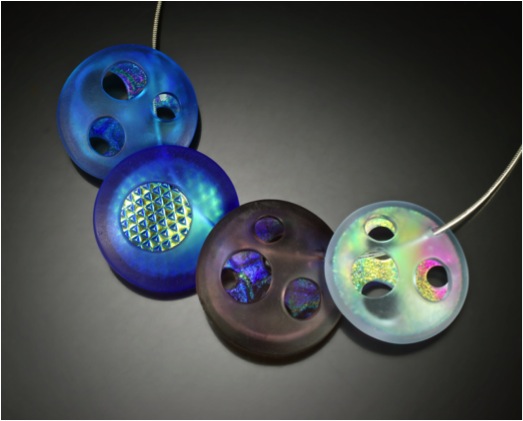
‘Cool Atomic Orbs’
Discuss the use of colour in your work?
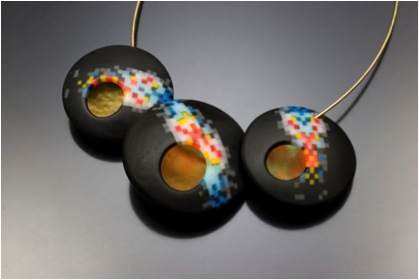
‘Pixel Nebula’
Colour is key in most of my work. It can evoke a feeling, even a genre (as in my Mid-Century inspired designs). I have, however, explored the use of light in black and clear glass and especially enjoy the use of colour gradation, just look to my Pixel Series. As evidence of this love affair, I often arrange the projects on my workbench by their place within the colour spectrum. I find the ordered blend of colours inspiring.
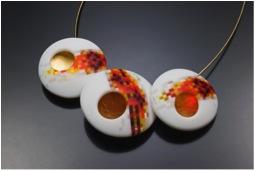
‘Pixel Flame’
You have your work in many galleries. Can you discuss the importance of a good relationship between an artist and gallery?
Gallery and artists have a symbiotic relationship and it’s essential to remember the importance of our respective roles. We provide the needed product and the gallery in turn provides the conduit to potential clients. Of course good communication is crucial, and we need to be willing to work this symbiosis into our working style.
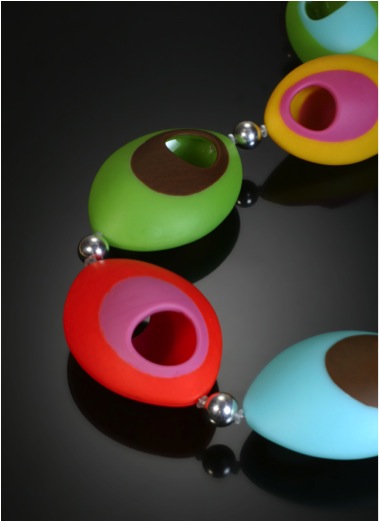
‘Mod Necklace’
Can you explain how your studio works and the type of equipment you have in it?
Since I deal primarily in jewellery, I am able to condense the bulk of my materials and machinery into my backyard studio building. In order of the production process: a design desk where the plans are drawn, a large movable central table for cutting glass, several kilns of various sizes for fusing and slumping, a grinding and drilling station for shaping the components, a pencil blaster for making those satin smooth matt surfaces, and an assembly area for finishing touches.
Discuss the care of your jewellery, both to wear and clean.
Glass is a very sturdy material. It will literally last for centuries. The advantage to fusing the glass into shapes is strength. The dome of the Pantheon has survived for thousands of years after all. One need only wipe it with a damp cloth and rub simple mineral oil on the surface to revive the satin finish.
Can you take two recent pieces you have made and discuss the inspiration and technique involved?
‘All Eyes are Upon You’ Necklace
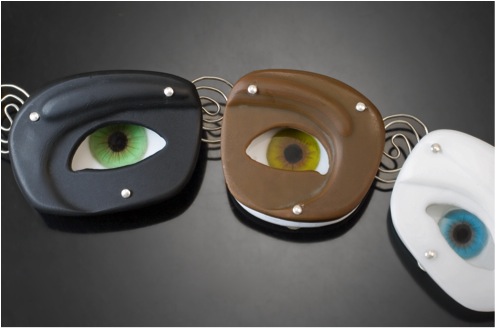
This was inspired by an early childhood memory. I was riding in the old family station wagon when I spied a clown face optical illusion painted on the wall of a passing building. The eyes appeared to move along with me as we drove by (yes, creepy I know!). A few months back, I was seeking a way to combine my porcelain painting with my glass work, so I fused and painted the realistic eyes on the surface of the glass and fashioned textured matt glass orifices that “float” over the top. The illusion works eerily well.
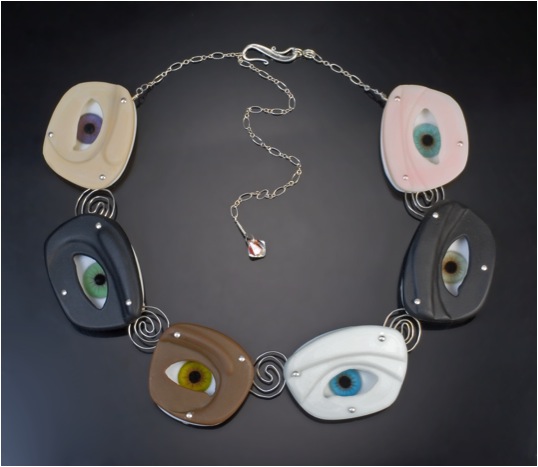
‘All Eyes are Upon You’ Necklace
‘Mod’ necklace
I have long had a love affair with Mid Century Modern design and architecture. Recently, I was able to attend Modernism Week in Palm Springs, California and designed this piece with hand-made marquis shaped moulds. It captures the essence of the movement in shape as well as classic colour combinations
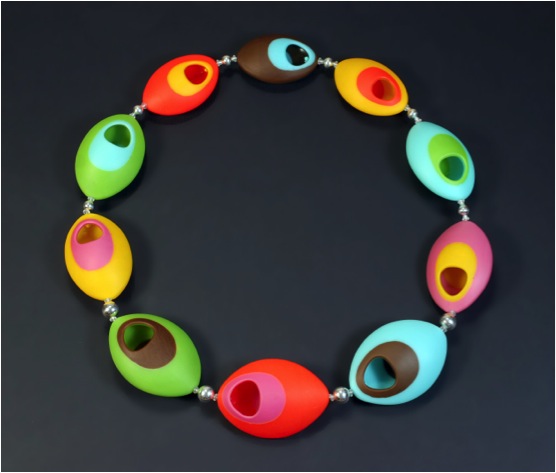
‘Mod’ Necklace
Discuss the different types of jewellery you make, eg rings, necklaces, etc…
The core of my work focuses on neckpieces and earrings. I have, however, delved into other types of adornment such as rings, watches, brooches, hair sticks, bolo ties, bracelets, and even belts.
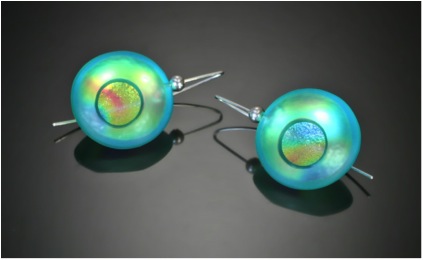
‘Atomic Earrings’ – Aqua
Contact details.
Email: barrettart@verizon.net
Web: www.barrettart.net
Dolores Barrett, California, USA
Interview by Deborah Blakeley, May 2014
Think a colleague or friend could benefit from this interview?
Knowledge is one of the biggest assets in any business. So why not forward this on to your friends and colleagues so they too can start taking advantage of the insightful information the artist has given?
Other artists you may be interested in:


